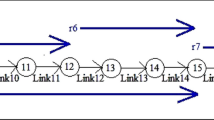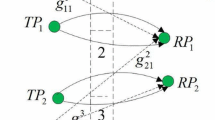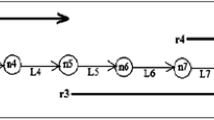Abstract
In this paper, by integrating together congestion control, power control and spectrum allocation, a distributed algorithm is developed to maximize the aggregate source utility and increase end-to-end throughput. Despite the inherent difficulties of non-convexity and non-separability of variables in the original optimization problem, we are still able to obtain a decoupled and dual-decomposable convex formulation by applying an appropriate transformation and introducing some new variables. The objective is accomplished by the interaction and coordination among three sub-algorithms of the algorithm through the congestion prices. The convergence properties of the three sub-algorithms are also proved. Simulation results illustrate several other desirable properties of the proposed algorithm, including the impacts of node mobility and path and packet losses on convergence and robustness. This work is a preliminary attempt towards a systematic approach to jointly designing a congestion control sub-algorithm and a power control sub-algorithm coupled with a spectrum allocation sub-algorithm.












Similar content being viewed by others
References
Mitola, J., & Maguire, G. Q. (1999). Cognitive radio: Making software radios more personal. IEEE Pers Commun, 6, 13–18.
Weiss, T. A., & Jondral, F. K. (2004). Spectrum pooling: An innovative strategy for the enhancement of spectrum efficiency. IEEE Commun Mag, 42, S8–S14.
Chen, L., Low, S. H., & Doyle, J. C. (2005). Joint congestion control and media access control design for ad hoc wireless networks. In Proceedings of IEEE Infocom, Vol. 3, March 2005, pp 2212–2222.
Lee, J.-W., Chiang, M., & Calderbank, A. R. (2006). Jointly optimal congestion and contention control based on network utility maximization. IEEE Communications Letters, 10(3), 216–218.
Yu, Y., & Giannakis, G. B. (2008). Cross-Layer congestion and contention control for wireless ad hoc networks. IEEE Transactions on Wireless Communications, 7(1), 37–42.
Tan, K., Jiang, F., Zhang, Q., & Shen, X. (2007). Congestion control in Multihop wireless networks. IEEE Transactions on Vehicular Technology, 56(2), 863–873.
Giannoulis, A., Salonidis, T., & Knightly, E. (2008). Congestion control and channel assignment in multi-radio wireless mesh networks. In Proceedings of IEEE Secon, June 2008, pp 350–358.
Chiang, M. (2005). Balancing transport and physical layers in wireless multiple networks: Jointly optimal congestion control and power control. IEEE Journal of Selected Areas in Communications, 23(1), 104–116.
Soldati, P., Johansson, B., & Johansson, M. (2008). Distributed cross-layer coordination of congestion control and resource allocation in S-TDMA wireless networks. Wireless Networks, 14, 949–965.
Gürses, E. (2008). Cross-layer optimized congestion, contention and power control in wireless Ad Hoc networks, Networking 2008, LNCS 4982, pp. 14–25.
Xu, W., Wang, Y., Chen, J., Baciu, G., & Sun, Y. (2008). Dual decomposition method for optimal and fair congestion control in Ad Hoc networks: Algorithm, implementation and evaluation. Journal of Parallel and Distributed Computing, 68(7), 997–1007.
Zhai, H., & Fang, Y. (2006). Distributed flow control and medium access in multihop ad hoc networks. IEEE Transactions on Mobile Computing, 5(11), 1503–1541.
Parag, P., Bhashyam, S., & Aravind, R. (2005). A subcarrier allocation algorithm for OFDMA using buffer and channel state information. In Proceedings of IEEE 62nd VTC, Vol. 1, September 2005, pp. 622–625.
Kim, I. et al. (2001). On the use of linear programming for dynamic subchannel and bit allocation in multiuser OFDM, IEEE GLOBECOM, November 2001, pp. 3648–3652.
Qin, X., & Berry, R. (2003). Exploiting multiuser diversity for medium access in wireless networks. In Proceedings of IEEE INFOCOM, Vol. 2, April 2003, pp. 1084–1094.
Qin, X., & Berry, R. (2004). Opportunistic splitting algorithms for wireless networks. In Proceedings of INFOCOM, Vol. 3, March, 2004, pp. 1662–1672.
Wang, D., Minn, H., & Al-Dhahir, N. (2009). A distributed opportunistic access scheme and its application to OFDMA systems. IEEE Transactions on Communications, 57(3), 738–746.
Bazerque, J.-A., & Giannakis, G. B. (2007). Distributed scheduling and resource allocation for cognitive OFDMA radios, 2nd International conference on cognitive radio oriented wireless networks and communications, CrownCom 2007.
Xi, Y., Yeh, & E. M. (2007). Distributed algorithms for spectrum allocation, power control, routing, and congestion control in wireless networks. In Proceedings of ACM, MobiHoc ‘07, September 2007, pp. 180–189.
Giannoulis, A., Salonidis, T., & Knightly, E. (2008). Congestion control and channel assignment in multi-radio wireless mesh networks. In Proceedings of IEEE SECON, 2008, pp. 350–358.
Quan, Z., Cui, S., & Sayed, A. H. (2008). Optimal linear cooperation for spectrum sensing in cognitive radio networks. IEEE Journal of Selected Topics in Signal Processing, 2(1), 28–39.
Goldsmith, A. (2004). Wireless communications. Cambridge, UK: Cambridge University.
Lin, X., & Ness, B. (2006). Shroff, utility maximization for communication networks with multipath routing. IEEE Transaction on Automatic Control, 51(5), 766–781.
Bertsekas, D. P., & Tsitsiklis, J. N. (1989). Parallel and distributed computation: Numerical methods. Upper Saddle River, NJ: Prentice-Hall.
Lee, J.-W., Chiang, M., & Calderbank, R. (2006). Optimal MAC design based on network utility maximization: Reverse and forward engineering. In Proceedings of IEEE INFOCOM 2006.
Chiang, M., Low, S. H., Calderbank, A. R., & Doyle, J. C. (2007). Layering as optimization decomposition: A mathematical theory of network architectures. Proceedings of the IEEE, 95(1), 255–312.
Lin, X., & Shroff, N. B. (2004). Utility maximization for communication networks with multi-path routing. Purdue University, West Lafayette, IN, Tech. Rep. http://min.ecn.purdue.edu/~linx/papers.html.
Bertsekas, D. P. (1999). Nonlinear programming (2nd ed.). Belmont: Athena Scientific.
Cali, F., Conti, M., & Gregori, E. (2000). Dynamic tuning of the IEEE 802.11 protocol to achieve a theoretical throughput limit. IEEE/ACM Transactions on Networking, 8(6), 785–799.
Yu, M., Malvankar, A., & Su, W. (2008). A distributed radio channel allocation scheme for WLANs with multiple data rates. IEEE Transactions on Communications, 56(3), 454–465.
Leung, K., & Kim, B. (2003). Frequency assignment for multi-cell IEEE 802.11 wireless networks. In Proceedings IEEE Vehicular Technology Conference (VTC’03), Orlando, FL, Oct. 2003.
Network Simulator, ns-2, Homepage, http://www.isi.edu/nsnam/ns.
Chen, J., He, S., Sun, Y., Thulasiraman, P., & Shen, X. (2009). Optimal flow control for utility-lifetime tradeoff in wireless sensor networks. Computer Networks, 53(18), 3031–3041.
Zhang, R., Liang, Y.-C., & Cui, S. (2010). Dynamic resource allocation in cognitive radio networks: A convex optimization perspective. IEEE Signal Processing Magazine: Special Issue on Convex Optimization on Signal Processing, 27(3), 102–114.
Yu, Y., Wang, L., & Yu, Q. (2009). Cross-layer architecture in cognitive Ad Hoc Networks, 2009 WRI International conference on communications and mobile computing. http://doi.ieeecomputersociety.org/10.1109/CMC.2009.142.
He, S., Chen, J., David K., Yau, Y., & Sun, Y. (2010). Cross-layer optimization of correlated data gathering in wireless sensor networks, IEEE SECON 2010. http://www.cs.purdue.edu/homes/lans/20061129/publications/he2010secon.pdf.
Acknowledgments
The work described in this paper was supported by the grants from the Research Grants Council of Hong Kong, China [Project No.: CityU113308], National Natural Science Foundation of China (60903213, 60973114), the Natural Science Foundation of Chongqing (CSTC, 2008BB2189, 2009BA2024), the Postdoctoral Science Foundation of China (20090460706) and National “Qian Ren Plan” of China.
Author information
Authors and Affiliations
Corresponding author
Appendix A: Proof of Theorem 3
Appendix A: Proof of Theorem 3
Frequently, in optimization problems to be solved with gradient method, the gradient is not computed exactly. It is easy to show that if there exists an error e (i) l in the gradient \( \nabla_{l}^{(i)} V_{power} \left( {p_{l}^{(i)} } \right), \) the gradient direction becomes \( \nabla_{l}^{(i)} V_{power} \left( {p_{l}^{(i)} } \right) + e_{l} . \)
Substituting \( p_{l}^{(i)} = e^{{\hat{p}_{l}^{(i)} }} \) into (25), we can get
It follows from (3) that
Substituting (41) into (40), we have
In our optimization problem, an error in G (i) jl leads to an error e (i) l in the gradient vector, from (43), this can be formulated as follows:
Let us consider the case that e (i) l is small relative to the gradient, that is,
By taking the square in both sides of (43) and adding, it follows that
Similarly, from (44), we can obtain
Substituting (45) and (46) into (44) and simplifying, one can get the result of Theorem 3. This completes the proof of Theorem 3.
Rights and permissions
About this article
Cite this article
Guo, S., Dang, C. & Liao, X. Distributed algorithms for resource allocation of physical and transport layers in wireless cognitive ad hoc networks. Wireless Netw 17, 337–356 (2011). https://doi.org/10.1007/s11276-010-0283-x
Published:
Issue Date:
DOI: https://doi.org/10.1007/s11276-010-0283-x




